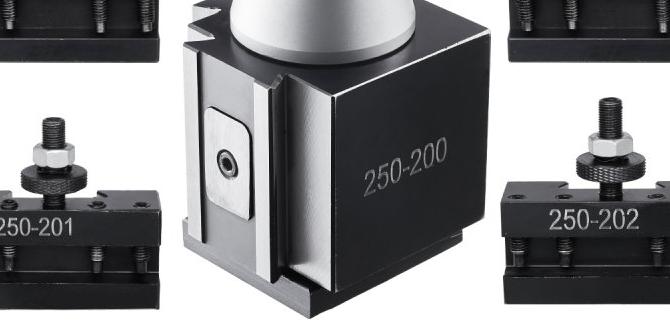Quick Summary:
A carbide end mill is the go-to cutting tool for machining titanium. Its hardness and heat resistance allow it to effectively cut tough titanium alloys like Grade 5, making it ideal for creating precise shapes and features in your projects.
Machining titanium can feel like a daunting task, especially for newcomers to the workshop. This incredibly strong and heat-resistant metal often leaves other cutting tools struggling. The good news is, there’s a champion tool for the job: the carbide end mill. If you’re looking to successfully cut titanium without frustration, you’ve come to the right place. We’re going to break down exactly why carbide is king and how to use it effectively. Get ready to tackle titanium with confidence!
Why Carbide End Mills Conquer Titanium
Titanium is a marvel of modern materials. It’s used in everything from aerospace components and medical implants to high-performance bicycle frames and even some consumer goods. Its strength-to-weight ratio is fantastic, and it holds up incredibly well under demanding conditions. However, these same qualities make it notoriously difficult to machine. Titanium has a tendency to gall (stick to the cutting tool), it generates a lot of heat when cut, and it’s generally much harder than materials like aluminum or mild steel.
This is where the carbide end mill shines. Tungsten carbide, the primary material in these tools, is exceptionally hard and can withstand high temperatures. When formulated correctly and used with the right cutting strategies, carbide end mills can slice through titanium efficiently, cleanly, and with less tool wear than other common tool materials like High-Speed Steel (HSS). Think of it like using a diamond-tipped saw for cutting stone – you need a material that’s harder than what you’re trying to cut.
The Magic of Tungsten Carbide
Tungsten carbide is an alloy made by combining tungsten and carbon. It’s created through a process called sintering, where fine powders of tungsten carbide and cobalt (acting as a binder) are heated under pressure. The result is a material that’s extremely hard but also quite brittle. However, for cutting tools, this extreme hardness is exactly what we need to overcome the toughness of materials like titanium.
The key advantages of carbide for machining titanium include:
- Extreme Hardness: Carbide is significantly harder than most metals, including titanium. This allows it to penetrate and shear titanium efficiently.
- High Heat Resistance: Machining creates friction, and friction creates heat. Carbide can tolerate much higher temperatures than HSS without losing its hardness or deforming. This is crucial for titanium machining, which generates substantial heat.
- Increased Tool Life: Because of its hardness and heat resistance, a carbide end mill can last much longer when cutting titanium compared to other tool types, even though it might be more expensive upfront.
- Better Surface Finish: The ability of carbide to maintain a sharp edge and resist deformation leads to cleaner cuts and a better surface finish on your titanium parts.
Choosing the Right Carbide End Mill for Titanium
Not all carbide end mills are created equal, and choosing the right one for titanium is crucial. You’ll want to consider a few key features:
End Mill Geometry
The shape and design of the end mill’s cutting edges play a big role. For titanium, you generally want:
- Fewer Flutes: Tools with 2 or 3 flutes are often preferred for titanium. More flutes can lead to chip packing in deeper cuts and increase the risk of chatter. The extra flute space in 2 and 3 flute designs helps evacuate chips more effectively.
- Irregular/Variable Pitch: Some specialized end mills have uneven spacing between their flutes (variable pitch) or slightly different helix angles. This helps break up the cutting force, reduce vibration, and improve chip evacuation, all of which are beneficial for tough materials like titanium.
- Specific Helix Angle: A moderate helix angle (often around 30 degrees) can offer a good balance between cutting action and tool rigidity for titanium.
- Corner Radii/Chamfers: To prevent chipping at the corners and provide extra strength, many end mills designed for titanium will have a small radius or a chamfer on the cutting edges.
Coatings
End mills can come with various coatings that enhance their performance. For titanium, look for:
- TiAlN (Titanium Aluminum Nitride): This is a very popular and effective coating for machining titanium. It forms a protective aluminum oxide layer at high temperatures, offering excellent thermal resistance and preventing the titanium work material from welding to the tool.
- AlCrN (Aluminum Chromium Nitride): Similar to TiAlN, AlCrN provides excellent heat resistance and wear resistance, often outperforming TiAlN in very high-temperature applications.
Material Grade – We’ll Focus on Grade 5 Titanium
When we talk about titanium for engineering and hobbyist projects, we’re often referring to Grade 5 titanium, also known as Ti-6Al-4V (Titanium, 6% Aluminum, 4% Vanadium). This is the most common alloy due to its excellent combination of strength, corrosion resistance, and weldability. However, it’s also one of the most challenging to machine. A carbide end mill specifically designed or recommended for Ti-6Al-4V will be your best bet. These are often categorized as “heat-resistant” alloys.
Shank Size and Reach
The shank is the non-cutting part of the end mill that fits into your machine’s tool holder. For general-purpose machining, an 8mm shank is common on smaller machines, and a 3/16 inch shank is also frequently used. For titanium, you’ll want a sturdy shank to handle the cutting forces. The “reach” refers to how far the cutting flutes extend down the tool. A “long reach” end mill can be helpful for accessing features deeper into a workpiece, but ensure your machine has the rigidity and power to handle longer tools, as they can be more prone to deflection.
Carbide End Mill Specifications for Titanium
Let’s look at some specifications you might encounter when searching for the perfect carbide end mill for titanium. Understanding these terms might seem complex, but break them down, and they make sense:
| Specification Example | Meaning for Titanium Machining |
|---|---|
| Diameter: 3/16 inch (or 8mm) | The cutting diameter of the end mill. Smaller diameters are good for detailed work, larger for faster material removal. |
| Shank Diameter: 3/16 inch (or 8mm) | The diameter of the shank that fits into the tool holder. A common size for many desktop CNC machines and smaller milling machines. |
| Number of Flutes: 2 or 3 | As mentioned, fewer flutes are better for titanium to promote chip clearance and reduce clogging. |
| Helix Angle: 30° – 45° | A moderate helix angle helps with chip evacuation and reduces cutting forces compared to a 0° (square) end mill. |
| Coating: TiAlN / AlCrN | Crucial for heat resistance and preventing material buildup. This is a must-have for tough alloys. |
| Material: Solid Carbide | Ensures maximum hardness and heat resistance. |
| Application: Titanium, Stainless Steel, Heat-Resistant Alloys | Confirms the tool is designed for challenging materials. |
| Corner Radius/Chamfer: 0.010″ – 0.030″ (or 0.25mm – 0.75mm) | Adds strength to the cutting edge, reducing the risk of chipping when machining hard materials. |
When you see something like “Carbide End Mill 3/16 inch 8mm Shank Long Reach for Titanium Grade 5 Heat Resistant,” it’s telling you exactly what you need. The key is that it’s designed “for Titanium” and often specifies coatings like TiAlN. The “heat resistant” aspect is covered by the carbide material and appropriate coatings. “Grade 5” confirms it’s suited for that specific, very common, and tough titanium alloy.
Setting Up Your Machine for Success
Even with the right tool, improper machine setup can lead to poor results or tool breakage. Here’s what to consider:
Rigidity is Key
Titanium is unforgiving of a wobbly or flexible machine. Ensure your milling machine bed, leadscrews, and especially your tool holder are as rigid as possible. Any vibration or flex will transfer to the cutting tool, leading to chatter, poor surface finish, and premature tool wear or breakage.
Spindle Speed and Feed Rate (The Cutting Parameters)
This is perhaps the most critical aspect of machining titanium and where carbide end mills really prove their worth. Because titanium is tough and generates heat, you need to find a balance between cutting too fast (which overheats the tool and workpiece) and too slow (which can cause rubbing and also generate heat, as well as poor chip formation).
Here are some general starting points, but always consult your end mill manufacturer’s recommendations or use your machine’s calculator:
- Spindle Speed (RPM): Often, you’ll be running carbide end mills for titanium at relatively low RPMs compared to softer materials like aluminum. For a 3/16 inch (or 8mm) end mill, you might start in the range of 500 – 2000 RPM.
- Feed Rate (IPM or mm/min): This is how fast the tool moves through the material. This is directly related to the RPM and the chip load (the thickness of the material each flute cuts). For titanium, you’ll generally want a firmer feed rate than for softer metals to ensure you’re actually cutting rather than rubbing. A good starting point for a 3/16″ (8mm) end mill might be between 5 to 15 inches per minute (around 125-380 mm/min).
- Chip Load: This is the thickness of the chip created by each cutting edge. For small carbide end mills in titanium, a chip load might be as small as 0.001″ to 0.002″ (0.025mm to 0.05mm) per flute. The feed rate is RPM Number of Flutes Chip Load. So, for example, 1000 RPM 2 flutes 0.0015″ chip load = 3 IPM. Always aim for a chip load that ensures the flute is actively cutting.
The objective is to create small, manageable chips that can be easily cleared away from the cutting zone. Too small a chip load leads to rubbing and friction; too large a chip load can overload the tool.
Coolant/Lubrication is Essential
While carbide is heat resistant, the workpiece and the cutting edge can still overheat, leading to tool failure or work hardening (making the titanium even harder and more difficult to cut). Proper coolant or lubrication is vital:
- Flood Coolant: A constant stream of coolant directed at the cutting zone is ideal. This cools the tool and workpiece, flushes away chips, and lubricates the cut.
- Mist Coolant: For machines that can’t handle flood coolant, a mist system sprays a fine mist of coolant and air.
- Specific Cutting Fluids: For titanium, you’ll want cutting fluids designed for exotic alloys or heavy-duty machining. These often contain additives to help with lubricity and cooling under high pressure. Avoid general-purpose lubricants.
- Air Blast: In a pinch or for very light cuts, a strong blast of compressed air can help, but it’s far less effective than liquid coolant for titanium.
A good resource for understanding cutting parameters is Machinery’s Handbook, a comprehensive guide used by machinists worldwide. You can find it at most technical bookstores or online retailers.
Step-by-Step: Machining Titanium with a Carbide End Mill
Let’s walk through a typical scenario. Imagine you need to mill a slot or a pocket in a piece of Grade 5 titanium using your new carbide end mill.
-
Secure Your Workpiece
This is paramount for safety and accuracy. Use robust clamping methods like machine vises with soft jaws, strap clamps, or fixtures. Ensure the titanium is held firmly and won’t shift during Machining. Always double-check that your clamps are not in the path of the cutting tool!
-
Secure Your End Mill
Insert your carbide end mill into your machine’s collet or tool holder. Ensure it’s seated correctly and tightened securely. A tool that isn’t held properly can cause runout (wobble), leading to poor cuts and tool breakage.
-
Set Up Coolant/Lubrication
Ensure your chosen coolant system is operational. Direct nozzles to the cutting zone where the end mill engages the titanium. Aim for a constant flow.
-
Set Your Cutting Parameters
Consult your end mill manufacturer’s data or start with the conservative values discussed earlier for spindle speed, feed rate, and chip load. It’s better to start a bit conservatively and increase if the cut is going smoothly.
-
Perform a Dry Run (Optional but Recommended)
Before plunging into the titanium, run the tool in the air at your programmed speeds and feeds to listen for any unusual noises or vibrations. This is a low-risk way to ensure your program is correct.
-
Initiate the Cut
Start your machine and, if not already running, activate the coolant. Gently feed the end mill into the titanium. For pocketing or slotting, you’ll typically use a helical interpolation or plunging move to get into the material, followed by the programmed toolpath.
-
Monitor the Cut
Listen to the sound of the cutting. A consistent, moderate “chip-chewing” sound is good. If you hear loud screaming, chattering, or heavy slamming, stop the machine immediately and adjust your speeds or feeds. Watch the chip formation – they should be small and well-formed, not stringy or powdery. Observe the temperature of the workpiece and tool; excessive heat is a sign you need to adjust.
-
Full Depth of Cut Strategy
For titanium, it’s often best to take lighter axial depths of cut (how deep the tool cuts into the material perpendicular to the surface) and more aggressive radial depths of cut (how much of the tool’s diameter engages the material sideways). This is often called “high-efficiency machining” or “trochoidal milling” for pockets, where the tool moves in a path that keeps the chip load consistent. This helps manage heat and cutting forces.
For example, instead of trying to cut 0.25 inches deep with a 3/16 inch end mill in one pass, you might take 2-3 passes of 0.06 to 0.10 inches deep, ensuring the radial engagement is appropriate for your carbide end mill.
-
Retract and Inspect
Once the machining is complete, retract the tool from the workpiece while it’s still spinning and coolant is flowing (if possible). Inspect your part and the end mill. Look for signs of excessive wear, chipping, or material buildup on the end mill.
Common Problems and Solutions
Even with the right tools and setup, you might encounter hiccups. Here are some common issues when machining titanium with carbide end mills:
- Tool Breakage: This is often caused by incorrect speeds/feeds, insufficient rigidity, poor chip evacuation leading to tool clogging, or plunging too aggressively.
- Solution: Double-check your cutting parameters, ensure your machine is rigid, use fewer flutes, ensure excellent coolant flow, and use appropriate plunging strategies (like helical interpolation).
- Poor Surface Finish (Chatter/Vibration): Indicates instability in the cutting process.
- Solution: Increase spindle speed slightly, decrease feed rate, ensure the end mill is sharp and not worn, check for backlash in your machine’s axes, ensure the tool holder is clean and gripping the end mill properly, and consider an end mill with a variable pitch or helix.
- Material Buildup (Galling): Titanium sticking to the end mill flutes.
- Solution: Ensure adequate coolant/lubrication. Verify the end mill has a proper coating (like TiAlN). Check if your chip load is too small, leading to rubbing instead of cutting. Sometimes, slightly increasing spindle speed or feed rate can help if the chip load is too low.
- Work Hardening: The titanium becomes harder during the cutting process, making it even more difficult to cut.






